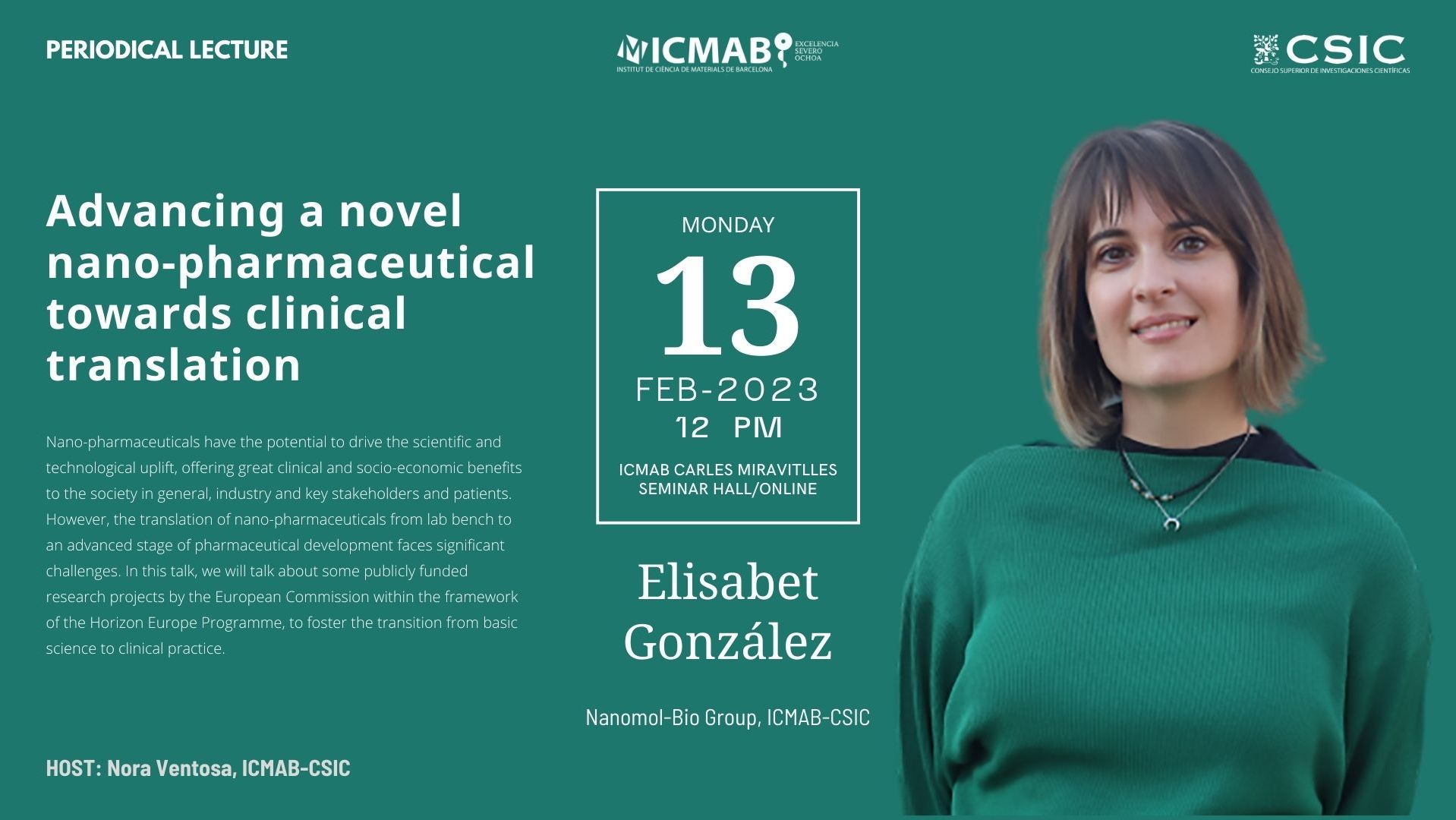Advancing a novel nano-pharmaceutical towards clinical translation
Prof Nora Ventosa, Scientific Director of NANBIOSIS U6 “Biomaterial Processing and Nanostructuring Unit” from CIBER-BBN and ICMAB-CSIC) is hosting the Lecture on nano-pharmaceuticals: “Advancing a novel nano-pharmaceutical towards clinical translation” by Elisabet González, from Nanomol-Bio Group of ICMAB-CSIC and CIBER-BBN
Monday, 13 February 2023
12 PM – 15 PM
ICMAB – Sala d’Actes Carles Miravitlles and ONLINE
Registration and futher information
Abstract: Nano-pharmaceuticals have the potential to drive the scientific and technological uplift, offering great clinical and socio-economic benefits to the society in general, industry and key stakeholders and patients. However, the translation of nano-pharmaceuticals from lab bench to an advanced stage of pharmaceutical development faces significant challenges: the high quality and quantity of these novel nanoformulations required for the preclinical (and further clinical) testing, the tight standards and regulations that must be complied with in this pharmaceutical field, and the increasing costs as development progresses, entails the major challenges, especially considering that the main players are usually research groups, spin-offs from academia or SMEs.
In this context, publicly funded research investment led by the European Commission within the framework of the Horizon Europe Programme is contributing to foster the transition from basic science to clinical practice. For example, by means of the EUH2020 Smart-4-Fabry Project (2017-2020), a novel nanomedicine for the Fabry disease treatment was developed up to an advance stage of preclinical development. For that, crucial considerations for early-stage product development were taken into account: these included identifying those critical quality attributes of the drug product essential for activity and safety, development and validation of advanced analytical methods (physical, chemical, biological) for characterization and quality control, identification and control of process parameters to ensure consistent batch-to-batch reproducibility, up-scaling manufacturing, and the use of adequate preclinical models.
Additionally, close collaboration with regulatory agencies from the early stages of development was carried to assure an aligned position and obtain a solid proof-of-concept. The outstanding efficacy results in preclinical models permitted to obtain an important milestone with strong implications for the translation of this new therapeutic product from bench to bedside: the Orphan Drug Designation by the European Medicines Agency (EMA). Currently, with the EU H2020 Phoenix Project (2021-2025), which aims to establish a Pharmaceutical Open Innovation Test Bed, together with the Project Innova4Fabry (2022-2023) from Innovators program (AGAUR), which aims to create a spin-off company, a smooth transfer of this novel therapy to clinical phase is pursued.
Dr. Elisabet González is senior researcher at the Nanomol-Bio group from ICMAB-CSIC and CIBER-BBN. She has extensive training in the field of Pharmaceutical Sciences. After the graduation of BSc in Pharmacy (2003), she held the MSc in Drug Research, Development and Control (2007), and the PhD in Pharmacy from the University of Barcelona (UB) (2011). Her 15+ years of scientific activity have been focused on the design of new type of nanoparticulate systems for technologically advanced applications in biomedicine (ocular and dermal inflammatory diseases, complex wounds, rare congenital metabolic diseases…).
Her pharmaceutical expertise has contributed to manage and coordinate multidisciplinary activities in the frame of national and international projects, which cover all key stages of the pharmaceutical development: from the design, manufacturing, characterization and quality control of nanoformulations to the preclinical and clinical development, and regulatory considerations. To highlight, she has played a key role in advancing the development of two effective nanoformulations from an experimental proof of concept (TRL3) to an advanced stage of preclinical development (TRL5), enabling with her first hand scientific-technical coordination the entrance of these nanoformulations to the regulatory preclinical phase.









